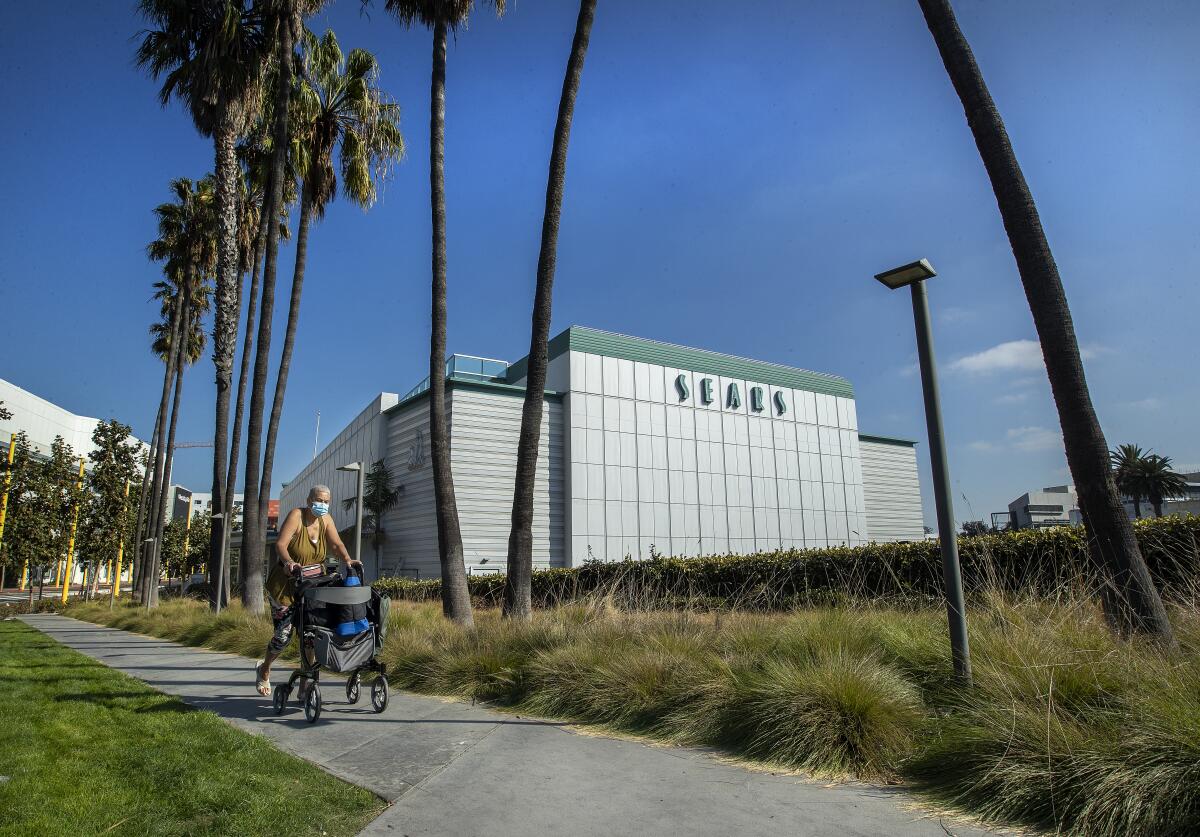The sad demise of Sears

- Share via
Like many people of a certain age, I’ve always had a soft spot for Sears. For much of my life, it was the go-to store for household appliances, clothing, tools and auto parts.
And then there’s the rich history of the Sears catalog, introduced in 1893. Long before the internet and the ubiquity of catalog merchants, the Sears catalog was for many Americans the sole way you could purchase a reliable good without traveling to a big-city store.
For a while, the Sears catalog ran about 1,200 pages and weighed 4 pounds.
So it’s with more than a little chagrin that I ask: What the heck happened to this company?
I’m not talking about the 2018 bankruptcy of parent company Sears Holdings or the hundreds of subsequent store closures.
In April, the Boyle Heights store hit the chopping block. The historic Santa Monica store is now office space. There may be only about three dozen Sears stores still operating nationwide.
And I’m not talking about the arrival of e-commerce and the rise of Amazon, although these obviously were body blows to many traditional retailers.
What I’m talking about is the demise of service at a company that virtually invented the idea of customer loyalty.
As founder Richard W. Sears said early in his career as a purveyor of timepieces: “If you buy a good watch you will always be satisfied, and at our prices a good watch will influence the sale of another good watch.”
Like me, Juana Hawk had nothing but good feelings about the Sears brand growing up. “I loved Sears,” the Houston resident said. “You could get anything and everything from them.”
Hawk, 64, was one of two Sears customers who contacted me in recent days to say she was being treated shabbily by the company.
The other was Jeremiah Ramirez , 43, who lives near Sacramento. Whereas Hawk’s story was one of needless inconvenience involving a dishwasher part she didn’t order, Ramirez’s tale is indicative of a business with serious problems on its hands.
It began with the Feb. 27 purchase of a Kenmore Elite electric range. The cost was about $1,600, marked down from $2,400.
“I knew that Sears stands for something,” Ramirez told me. “They stand behind what they sell.”
Not this time.
The range was supposed to be delivered three weeks after Ramirez made the purchase. It didn’t arrive until April 17. The trouble began a few days later.
“The first time I used the broiler, there was a loud explosion — louder than a firecracker — and the kitchen quickly filled with black smoke,” Ramirez recalled. “Something literally blew up inside the stove.”
He immediately called Sears, and the company sent out a repair guy, who diagnosed a faulty power regulator in the appliance.
The repair guy told Ramirez he’d return in several weeks with either a replacement part or a whole new stove. He didn’t. And every time Ramirez reached out to the company, he was told to be patient.
April turned to May, and May turned to June. Ramirez received an email a few weeks ago saying Sears was hopeful a replacement part for his blown-up stove would arrive by the end of this month.
Remember: He bought the range in February and has been without a working stove ever since.
“At this point I’m thinking the whole thing is absurd,” Ramirez said. “I asked for them to take the stove away and refund my money.”
Sears’ response? A service rep said refunds can be offered only within 30 days of a purchase.
Ramirez pointed out that he didn’t even receive the stove for almost 60 days. How could he know there’d be a problem?
“They had no answer,” he said. “They just kept saying there was nothing they could do.”
In Hawk’s case, she said the motor in her Sears dishwasher “got fried.” A repair guy showed up a few weeks later and determined that, yep, her dishwasher motor was fried. He ordered a new one.
Sears sent it to the wrong address. A few weeks after that, the motor arrived at her home and the repair guy arrived to make the fix.
Then another motor was delivered.
“I’m a good Samaritan,” Hawk told me. “I called them and told them to come get their part.”
That was in April. The part is still sitting on her porch.
“I kept telling Sears they should come get it because this is a neighborhood where people steal stuff.”
So she emailed me and I emailed Sears. Hawk said a company worker called her last week to say she should just throw out the dishwasher motor because, at this point, it couldn’t be resold.
Each motor sells for nearly $300. Hawk said she wanted it in writing that she wouldn’t be charged for the part. Now she’s waiting on that.
In Ramirez’s case, a few days after I contacted Sears on his behalf, he received an email from a company exec saying that because a replacement part for his stove isn’t available, they’ll refund his money and cart away the defective unit.
Ramirez noted that the email didn’t contain an apology, and it will still probably be weeks before he’s no longer cooking in his backyard on a camp stove.
“But at least I won’t have to deal with Sears anymore,” he told me.
It’s sad. Sears is one of the most storied names in American retail. How could the company have sunk this low?
Sears merged with Kmart in 2004, in a deal engineered by Kmart Chairman Edward Lampert (fun fact: he was former Treasury Secretary Steven Mnuchin’s roommate at Yale).
Lampert wasn’t the most astute manager. Sears Holdings lost $10.4 billion from 2011 to 2016. In 2014, the company’s debt was larger than its stock valuation.
Sears then began an ugly cycle of selling off its assets and laying off employees. Bankruptcy followed. And lawsuits.
Sears and Kmart are now owned by something called Transformco, which I assume is either an Autobot or a Decepticon. All I know is that it’s absurdly hard to reach anyone there.
No one at Transformco responded to my questions about Hawk’s and Ramirez’s situations, or the current state of the company’s customer service.
I keep thinking back to that quote from Sears’ founder, the one about how selling a good watch at a good price will lead to customers buying more watches.
Here’s another quote: “We see our customers as invited guests to a party, and we are the hosts. It’s our job every day to make every important aspect of the customer experience a little bit better.”
Richard W. Sears didn’t say that. Amazon’s Jeff Bezos did.
A Sears for the 21st century.
More to Read
Inside the business of entertainment
The Wide Shot brings you news, analysis and insights on everything from streaming wars to production — and what it all means for the future.
You may occasionally receive promotional content from the Los Angeles Times.










